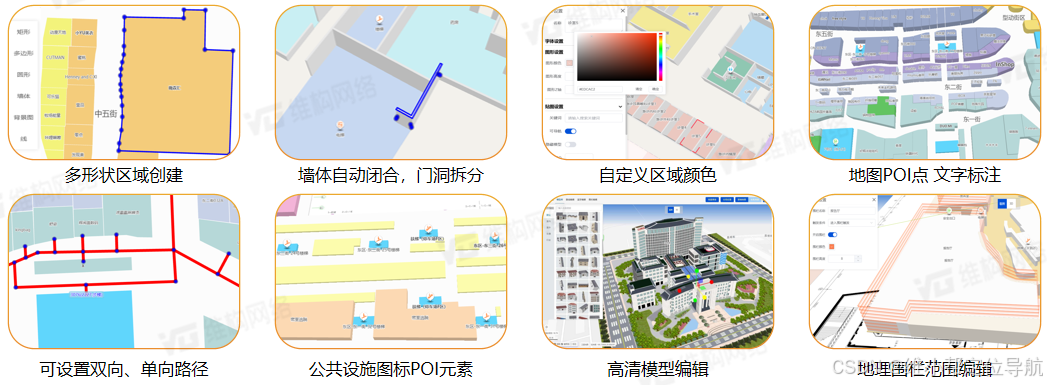本文面向算法工程师、GIS 开发者以及对路径规划感兴趣的读者,重点讲解如何通过 A* 算法实现校园场景下的最优路径搜索,并分享时间复杂度优化与动态调整策略。如需获取校智慧校园导航系统技术文档可前往文章最下方获取,如有项目合作及技术交流欢迎私信我们哦~
一、带权图的校园路网建模
在校园导航系统中,路径规划的核心是对校园路网进行建模。我们可以将校园路网抽象为一个带权图,其中节点代表路口或关键位置,边代表路径,权重代表路径的代价(如距离、时间或难度)。
1. 障碍物规避
在校园中,障碍物(如建筑物、花坛)是不可通行的区域。我们需要在图中将这些区域标记为不可达节点。
2. 楼梯权重系数
楼梯的通行代价通常高于平路,因此可以为楼梯路径设置更高的权重系数。例如:
- 平路权重:1
- 楼梯权重:2
3. 路网建模示例
以下是一个简单的校园路网带权图建模:
# 校园路网带权图
graph = {
'A': {'B': 1, 'D': 1}, # A 到 B 和 D 的路径权重为 1
'B': {'A': 1, 'C': 2}, # B 到 C 的路径是楼梯,权重为 2
'C': {'B': 2, 'D': 1}, # C 到 D 的路径权重为 1
'D': {'A': 1, 'C': 1} # D 到 A 和 C 的路径权重为 1
}二、改进 A* 算法的时间复杂度优化
A* 算法是一种经典的启发式搜索算法,通过结合 Dijkstra 算法的最短路径搜索和启发式估计,能够高效地找到最优路径。然而,在大规模路网中,A* 算法的时间复杂度可能较高。以下是两种优化方法:
1. 二叉堆实现优先队列
A* 算法需要频繁地从开放集中取出最小代价节点。使用二叉堆(Heap)可以将这一操作的时间复杂度从 O(n) 降低到 O(log n)。
import heapq
def a_star(graph, start, goal):
open_set = []
heapq.heappush(open_set, (0, start)) # 使用二叉堆实现优先队列
came_from = {}
g_score = {node: float('inf') for node in graph}
g_score[start] = 0
f_score = {node: float('inf') for node in graph}
f_score[start] = heuristic(start, goal)
while open_set:
_, current = heapq.heappop(open_set)
if current == goal:
return reconstruct_path(came_from, current)
for neighbor, weight in graph[current].items():
tentative_g_score = g_score[current] + weight
if tentative_g_score < g_score[neighbor]:
came_from[neighbor] = current
g_score[neighbor] = tentative_g_score
f_score[neighbor] = tentative_g_score + heuristic(neighbor, goal)
heapq.heappush(open_set, (f_score[neighbor], neighbor))
return None2. 启发函数优化
启发函数的设计直接影响 A* 算法的效率。常用的启发函数包括曼哈顿距离和欧几里得距离。在校园场景中,曼哈顿距离更适合网格状路网。
def heuristic(node, goal):
# 曼哈顿距离启发函数
return abs(node[0] - goal[0]) + abs(node[1] - goal[1])三、动态调整策略:施工路段实时规避
校园中可能存在临时施工路段,导航系统需要实时调整路径规划。以下是实现动态调整的策略:
1. 施工路段标记
在路网图中,将施工路段标记为临时障碍物(权重设置为无穷大)。
# 动态更新施工路段
graph['B']['C'] = float('inf') # B 到 C 的路径因施工不可通行2. 实时路径更新
当检测到施工路段时,重新运行 A* 算法计算新路径。
def dynamic_avoidance(graph, start, goal, blocked_edges):
# 标记施工路段
for edge in blocked_edges:
graph[edge[0]][edge[1]] = float('inf')
# 重新计算路径
return a_star(graph, start, goal)
# 示例:B 到 C 的路径因施工不可通行
blocked_edges = [('B', 'C')]
print(dynamic_avoidance(graph, 'A', 'D', blocked_edges)) # 输出新路径四、完整代码示例
以下是完整的 A* 算法实现,包括带权图建模、二叉堆优化和动态调整策略:
import heapq
def a_star(graph, start, goal):
open_set = []
heapq.heappush(open_set, (0, start))
came_from = {}
g_score = {node: float('inf') for node in graph}
g_score[start] = 0
f_score = {node: float('inf') for node in graph}
f_score[start] = heuristic(start, goal)
while open_set:
_, current = heapq.heappop(open_set)
if current == goal:
return reconstruct_path(came_from, current)
for neighbor, weight in graph[current].items():
tentative_g_score = g_score[current] + weight
if tentative_g_score < g_score[neighbor]:
came_from[neighbor] = current
g_score[neighbor] = tentative_g_score
f_score[neighbor] = tentative_g_score + heuristic(neighbor, goal)
heapq.heappush(open_set, (f_score[neighbor], neighbor))
return None
def heuristic(node, goal):
return abs(node[0] - goal[0]) + abs(node[1] - goal[1])
def reconstruct_path(came_from, current):
path = [current]
while current in came_from:
current = came_from[current]
path.append(current)
return path[::-1]
def dynamic_avoidance(graph, start, goal, blocked_edges):
for edge in blocked_edges:
graph[edge[0]][edge[1]] = float('inf')
return a_star(graph, start, goal)
# 示例图
graph = {
'A': {'B': 1, 'D': 1},
'B': {'A': 1, 'C': 2},
'C': {'B': 2, 'D': 1},
'D': {'A': 1, 'C': 1}
}
# 动态规避施工路段
blocked_edges = [('B', 'C')]
print(dynamic_avoidance(graph, 'A', 'D', blocked_edges)) # 输出: ['A', 'D']五、产品亮点与优势
- 高效路径规划:A* 算法结合二叉堆优化,支持大规模路网。
- 动态调整能力:实时规避施工路段,确保路径可用性。
- 灵活建模:支持自定义权重系数,适应多样化场景。
六、总结
本文详细讲解了如何通过 A* 算法实现校园场景下的最优路径搜索,并分享了时间复杂度优化与动态调整策略。通过带权图建模、二叉堆优化和实时规避策略,可以构建一个高效、灵活的校园导航系统。
相关文章:
校园导航系统架构设计:如何用GIS+算法处理百万级路径规划?
下期预告:
《校园电子地图制作:从CAD图纸到WebGIS服务的完整链路》敬请期待!
如需查看校园导航技术文档可点击文章最下方↓
